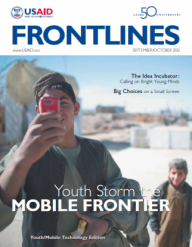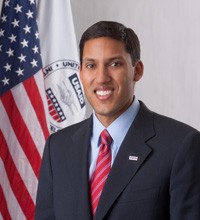Many people will tell you that global challenges today are simply too big and complex to overcome. Challenges like ending extreme poverty or ending preventable child death. Challenges like ensuring all children are learning in their classrooms, or expanding access to clean, off-grid energy.
But the truth is that today, more than ever, we have the technologies and knowledge to confront these challenges and brighten the future for millions of people around the world. In fact, one of the most powerful tools for development in existence is also one of the most ubiquitous.
Today, thanks to cell phones, poor farmers can use text messages to compare prices and sell what they grow at higher prices. Community health workers can use phones to collect information and track disease outbreaks in real time. Protestors can use them to document and share videos of electoral violence. And mobile banking can give billions without an account the opportunity to save money for the very first time.
Technology can’t solve every problem we face, but new tools can change the reality of what’s possible. In fact, in the last few years, some of our best ideas have come from young people who have the optimism and determination to harness these new tools and change the world for the better.
Through our Development Innovation Ventures fund, we’re investing in a team of young graduates who started a company called EGG-energy to help provide off-grid electricity to homes across Tanzania. They call it the “Netflix solution.” Low-income families rent out portable, rechargeable, affordable batteries to power their homes for five nights at a time.
In Tanzania, where 90 percent of people lack access to electricity-but 80 percent live within 5 kilometers of the power grid-this could be a unique solution to a pervasive problem in development.
That’s the purpose of our Innovation Ventures fund-to support entrepreneurs who have a great idea and need the resources to test it. If they can prove through rigorous evaluation that their idea works, we can also provide funding to help them bring their solutions to scale.
That isn’t the only way we’re reaching out to young innovators. Last year, we launched a series of global competitions called Grand Challenges for Development that encourage scientists, researchers and entrepreneurs to generate game-changing solutions to particularly difficult problems in development.
Our first Grand Challenge—called Saving Lives at Birth—attracted more than 600 ideas to help mothers give birth safely in remote or impoverished settings. One of those applicants was a young graduate in bioengineering who had designed a simple, affordable alternative to an expensive machine that helps resuscitate newborns suffering from respiratory failure.
In Western hospitals, that machine costs up to $6,000, and it requires specialized training and a stable source of electricity. Using a plastic bottle and household aquarium pumps, the young innovator helped build an easy-to-use, battery-run resuscitation device at one-fortieth the cost. With a USAID grant, her team took that device to Malawi, where they had it on hand when a non-responsive infant girl arrived at a local hospital.
Within minutes, the device had saved her life.
These solutions didn’t come from professionals who’ve been in the field for three decades. They came from young people, and astoundingly, they arrive from everywhere-from entrepreneurs, universities and research labs across the developing world.
But in order to effectively realize the power of these innovations and truly leave behind generational legacies of success, we have to recommit ourselves to incorporating new technologies into our work from the very beginning.
Instead of collecting information using paper surveys, which is often expensive and results in data-entry errors, we can use mobile devices. Instead of paying contractors to collect baseline data, we can crowd-source information and combine it with sector-specific and demographic data sets. Instead of relying on the use of cash in our own development projects, we can save money, reduce corruption, and drive greater efficiencies through the use of electronic and mobile payments.
These strategic decisions will not only be more efficient. They will also amplify the voices of the poor, enabling their input to be incorporated back into program design and evaluation so that we continue to improve as an organization dedicated to advancing human welfare and opportunity.










Comment
Make a general inquiry or suggest an improvement.